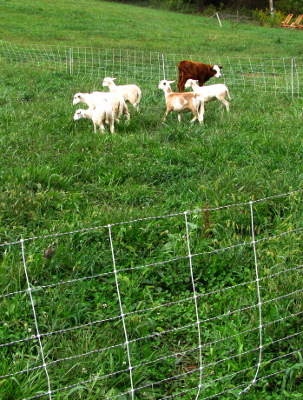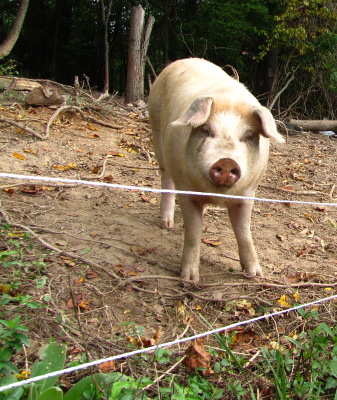
Electric fences for pasture rotation
 The heart of the multi-annual
pasturing setup is pasture
rotation. By
"mob-stocking" lots of animals in a small space, the livestock are
forced to eat everything rather than just nibbling on their favorite
plants. Then you move the animals to a new paddock quickly,
before they can eradicate those favorite plants. Your animals are
healthier because they eat better food and don't pick up diseases from
their own waste, and the pasture is more productive and diverse because
the least tasty plants don't take over.
The heart of the multi-annual
pasturing setup is pasture
rotation. By
"mob-stocking" lots of animals in a small space, the livestock are
forced to eat everything rather than just nibbling on their favorite
plants. Then you move the animals to a new paddock quickly,
before they can eradicate those favorite plants. Your animals are
healthier because they eat better food and don't pick up diseases from
their own waste, and the pasture is more productive and diverse because
the least tasty plants don't take over.
That sounds great, but
how do you make the animals graze one small area and then move them to
a fresh spot quickly and easily? Chicken tractors are Joel
Salatin's method of mob-stocking broilers, but he relies on electric
fences for most other livestock. Each type of animal requires a
specific type of electric fencing --- two strands close to the ground
are plenty for the tender-nosed pig, but Megan relies on electrified
netting to keep her lambs in bounds.
 Electric fencing has the
benefit that it's easy to rearrange --- Erek takes about eight minutes
to move the lambs to a new paddock each day --- so you can graze the
whole pasture evenly without getting weedy plants growing up along
permanent fencelines. On the other hand, electric fence has some
major disadvantages too. Megan admits that the netting is nearly
impossible to deal with in the woods since it tangles up quickly, and,
of course, you have to keep weeds from growing high enough to touch the
wires or they'll drain the electricity out of the fence. And startup costs are steep (although startup labor is low.)
Electric fencing has the
benefit that it's easy to rearrange --- Erek takes about eight minutes
to move the lambs to a new paddock each day --- so you can graze the
whole pasture evenly without getting weedy plants growing up along
permanent fencelines. On the other hand, electric fence has some
major disadvantages too. Megan admits that the netting is nearly
impossible to deal with in the woods since it tangles up quickly, and,
of course, you have to keep weeds from growing high enough to touch the
wires or they'll drain the electricity out of the fence. And startup costs are steep (although startup labor is low.)
I have a feeling that
electric fencing is one of the aspects of Salatin-style pasturing that
carries over least well to the small homestead. But more on that
topic tomorrow!
| This post is part of our Salatin-style Pasturing lunchtime series.
Read all of the entries: |
Want more in-depth information? Browse through our books.
Or explore more posts by date or by subject.
About us: Anna Hess and Mark Hamilton spent over a decade living self-sufficiently in the mountains of Virginia before moving north to start over from scratch in the foothills of Ohio. They've experimented with permaculture, no-till gardening, trailersteading, home-based microbusinesses and much more, writing about their adventures in both blogs and books.
Want to be notified when new comments are posted on this page? Click on the RSS button after you add a comment to subscribe to the comment feed, or simply check the box beside "email replies to me" while writing your comment.

New blog reader here. I homestead on about three acres. What we have been doing is using a one-strand hotwire to rotationally graze our milk cow, then running our chicken tractors a few days behind her. It has been working really well for us, but then, a dairy cow is one of the easiest animals to fence.
Lucy, Milk and Honey Farm